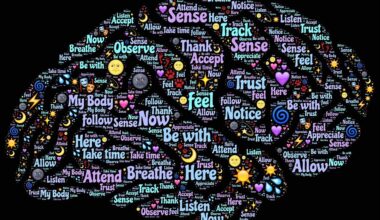Best Gym Exercises for Weight Loss
When it comes to achieving weight loss goals, the right gym exercises can make a significant difference. Combining strength training and cardiovascular workouts provides optimal results. Among the most effective exercises are squats, lunges, and deadlifts. Squats target multiple muscle groups, helping to sculpt the lower body while burning calories. Lunges improve balance and stability, engaging your legs and core. Deadlifts work the back, legs, and core, offering a robust full-body workout. Additionally, incorporating high-intensity interval training (HIIT) can further enhance fat loss. HIIT involves short bursts of intense activity followed by rest, maximizing calorie burn. Remember, form is key in these exercises; consult a trainer if uncertain about your technique. Mixing cardio, such as running or cycling, adds variety to your routine while keeping the heart healthy. Also, track progress to stay motivated. Document workouts, note improvements, and set realistic goals. Adopting a comprehensive approach to weight loss combining proper exercises, nutrition, and hydration leads to enduring results. Always consult healthcare professionals before beginning any exercise regimen, ensuring a safe, effective path toward personal health objectives.
A well-structured routine is essential for success in your weight loss journey. Start by creating a balanced workout schedule that incorporates various exercises, including strength training and cardio. Aim for at least three days of strength training each week. Focus on compound movements such as bench presses, overhead presses, and rows. These movements engage multiple muscle groups, providing a more efficient calorie-burning potential. On alternating days, incorporate cardiovascular workouts like jogging, cycling, or group fitness classes. Aim for at least 150 minutes of moderate-intensity cardio each week for optimal fat loss. Including flexibility training, such as yoga or stretching, can also enhance recovery and prevent injuries. Structure workouts into a manageable routine that you can progressively intensify. For example, gradually increase weights or duration as you build strength and endurance. Workout sessions should last 45 to 60 minutes to maximize results. Also, listen to your body and allow adequate rest between sessions. This balance will help maintain motivation and reduce the risk of burnout. Personalized fitness plans that account for individual needs and preferences lead to sustainable progress in weight loss.
Incorporating Resistance Training
Resistance training plays a crucial role in any weight loss exercise program. Not only does it build muscle, but it also boosts metabolism, helping to burn more calories at rest. Various forms of resistance training can be utilized, such as free weights, machines, and bodyweight exercises. Starting with lighter weights and focusing on proper form is essential for beginners. Gradually increase weights as confidence and strength improve. Key exercises like push-ups, or bent-over rows can be done with minimal equipment and are highly effective. Bodyweight exercises, like plank variations, work core stability and strength, providing versatility. Whole-body routines that target all major muscle groups are most beneficial for weight loss. Consider including supersets, where two exercises are performed back-to-back with minimal rest. This approach increases intensity and energy expenditure while maintaining muscle engagement. It’s important to allow rest days after intense workouts to enable recovery. Lastly, nutrition should complement the workout regime, emphasizing protein intake to support muscle repair and growth. This holistic approach aids in maintaining a caloric deficit for weight loss while enhancing overall fitness and health.
In addition to structured exercises, engaging in functional fitness activities helps with weight loss. These exercises mimic everyday movements, improving strength and coordination while burning calories. Examples include kettlebell swings, box jumps, and medicine ball slams. Functional training enhances mobility, making daily tasks easier while simultaneously aiding in weight loss. Moreover, consider group classes to foster accountability and motivation. Classes like Zumba, kickboxing, or spin are not only fun but also provide high-energy cardiovascular workouts. Participating with others encourages adherence to your fitness regimen and reduces monotony. If gym classes aren’t available, consider utilizing online platforms offering live or recorded workout sessions. This flexibility allows you to stay active according to personal schedules. Remember to mix workouts and change routines regularly to prevent plateaus. Varying exercises shock the muscles, compelling them to adapt and grow stronger. Incorporating active recovery days, such as gentle yoga or stretching, can also benefit overall fitness levels. By integrating functional fitness and community support, you can achieve your weight loss goals while enjoying the process. Always prioritize safety and maintain proper form during every workout.
Cardio’s Important Role
Cardiovascular exercise remains a staple in effective weight loss strategies. A well-rounded fitness program includes at least two to three cardio sessions weekly, engaging in various activities to keep things interesting. Choose activities you enjoy, such as running, swimming, or dancing, as this enhances adherence and enjoyment. Consistency is key; aim for at least 30 to 60 minutes per session. To boost intensity, consider incorporating interval training during cardio sessions. For example, alternate between periods of high effort and low effort to maximize fat burn. Furthermore, utilizing tools like heart rate monitors can provide feedback, ensuring you’re working within your target heart rate zones, thereby optimizing your workouts. Outdoor activities like hiking provide not only physical benefits but also psychological ones, promoting mental well-being and relaxation. Incorporating music or social settings can elevate enjoyment levels during cardio workouts. Additionally, keep hydration in check during more intense sessions as this supports overall performance. By understanding the essential role of cardio and incorporating it meaningfully into your exercise routine, you’ll better support your weight loss objectives while fostering lasting fitness habits.
A balanced diet works hand-in-hand with an effective exercise regime to ensure successful weight loss. Proper nutrition fuels workouts and aids recovery while creating a caloric deficit. Focus on whole, nutrient-dense foods such as lean proteins, whole grains, fruits, and veggies. Foods high in fiber, like legumes and grains, promote satiety, helping you feel fuller longer. Consider meal prep as a great way to maintain healthy eating habits throughout the week, reducing reliance on takeout or unhealthy snacks. Portion control plays a vital role as well—use smaller plates to help with portion sizes visually. Staying mindful about eating habits and resisting emotional eating is essential for progress. Tracking your meals can help identify triggers and patterns in consumption. Alongside balanced meals, remember to stay hydrated, as water supports metabolism and energy levels. Aim for at least half your body weight in ounces daily. Lastly, consider consulting a nutritionist to develop personalized meal plans that complement your exercise regime. With a focus on balanced nutrition and well-timed meals, you will find it easier to achieve your weight loss goals effectively and sustainably.
Setting Achievable Goals
Setting achievable goals is a crucial component of any weight loss journey. Clear, specific, and realistic targets encourage motivation and commitment. Begin by identifying short-term goals, such as losing a few pounds, establishing a consistent workout routine, or mastering a new exercise. These short-term goals can build confidence and create a sense of accomplishment. Also, consider adopting a mixed approach by establishing both performance and outcome goals. Performance goals could involve running a certain distance without stopping or lifting a specific weight. In contrast, outcome goals concentrate on a tangible weight loss number. Don’t forget the importance of tracking your progress; this can include fitness journaling or utilizing applications that record workouts and nutritional intake. Regularly reviewing these targets helps maintain accountability. Adjusting goals as needed encourages continual growth and reduces frustration. Celebrate milestones along the way, both big and small, as positive reinforcement exceeds essential motivation. Most importantly, remain patient with yourself and embrace setbacks as opportunities for learning and growth. By employing effective goal-setting strategies, you’ll stay focused and motivated throughout your journey to achieve lasting weight loss results.
Ultimately, the best gym exercises for weight loss encompass a combination of strength training, cardio, and flexibility workouts. Focusing on form and gradually increasing intensity ensures sustainable progress. Embrace a well-rounded routine, mixing various exercises to target different muscle groups while preventing boredom. Establishing a supportive network, whether at the gym or in online fitness communities, encourages adherence to your program. Remember to listen to your body, allowing for adequate rest and recovery, and adjusting workouts as needed. Integrate healthy eating habits and proper hydration into your routine to further enhance weight loss efforts. By staying consistent and committed to your fitness journey, you will undoubtedly achieve the body and health you desire. Overcoming obstacles along the way will only strengthen your resilience and determination. Emphasize patience and persistence; results may take time, but every step taken contributes to overall health. Finally, embracing a healthy lifestyle beyond the gym will promote lasting changes. Focusing on long-term health, rather than just aesthetic goals, will foster a more positive relationship with fitness and nutrition. With dedication and discipline, weight loss success in the gym can certainly be achievable.


